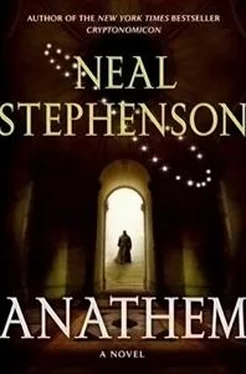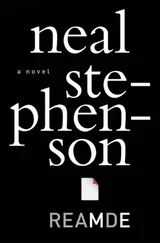“Would you call it a war, or just mad scrambling around?”
“That’s what I was trying to figure out,” he said. “In a war, you have strategy and tactics. Like flanking. Can ants flank?”
I barely knew what that meant: attacking from the side. Lio worried such terms loose from old books of vlor—Vale-lore—as if pulling dragon’s teeth from a fossil jaw.
“I suppose ants can flank,” I said, though I sensed that it was a trick question and that Lio was flanking me with words at this very moment. “Why not?”
“By accident, of course they can! You look down on it from above and say, ‘Oh, that looked like flanking.’ But if there’s no commander to see the field and direct their movements, can they really perform coordinated maneuvers?”
“That’s a little like Saunt Taunga’s Question,” I pointed out (“Can a sufficiently large field of cellular automata think?”).
“Well, can they?”
“I’ve seen ants work together to carry off part of my lunch, so I know they can coordinate their actions.”
“But if I’m one of a hundred ants all pushing on the same raisin, I can feel the raisin moving, can’t I—so the raisin itself is a way that they communicate with one another. But, if I’m a lone ant on a battlefield—”
“Thistlehead, it’s Provener.”
“Okay,” he said, and turned his back on me and started walking. It was this penchant for dropping conversations in the middle, among other odd traits, that had earned him a reputation as being less than intact. He’d forgotten his sphere again. I picked it up and threw it at him. It bounced off the back of his head and flew straight up in the air; he held out a hand, barely looking, and caught it on the drop. I edged around the battlefield, not wanting to get combatants, living or dead, on my feet, then hustled after him.
Lio reached the corner of the Cloister well ahead of me and ducked in front of a mass of slow-moving suurs in a way that was quite rude and yet so silly that the suurs all had a chuckle and thought no more of it. Then they clogged the archway, trapping me behind them. I had alerted Fraa Lio so he wouldn’t be late; now I was going to arrive last and be frowned at.
Aut:(1) In Proto- and Old Orth, an act; an action deliberately taken by some entity, usually an individual. (2) In Middle and later Orth, a formal rite, usually conducted by an assembly of avout, by which the math or concent as a whole carries out some collective act, typically solemnized by singing of chants, performance of coded gestures, or other ritual behavior.
— THE DICTIONARY, 4th edition, A.R. 3000
In a sense the clock was the entire Mynster, and its basement. When most people spoke of “the clock,” though, they meant its four dials, which were mounted high on the walls of the Præsidium — the Mynster’s central tower. The dials had been crafted in different ages, and each showed the time in a different way. But all four were connected to the same internal works. Each proclaimed the time; the day of the week; the month; the phase of the moon; the year; and (for those who knew how to read them) a lot of other cosmographical arcana.
The Præsidium stood on four pillars and for most of its height was square in cross-section. Not far above the dials, however, the corners of the square floor-plan were cleaved off, making it into an octagon, and not far above that, the octagon became a sixteen-sided polygon, and above that it became round. The roof of the Præsidium was a disk, or rather a lens, as it bulged up slightly in the middle to shed rainwater. It supported the megaliths, domes, penthouses, and turrets of the starhenge, which drove, and was driven by, the same clock-works that ran the dials.
Below each dial was a belfry, screened behind tracery. Below the belfries, the tower flung out plunging arcs of stone called buttresses to steady itself. Those found footing amid the topmost spires of four outlying towers, shorter and squatter than the Præsidium, but built to the same general plan. The towers were webbed to one another by systems of arches and spans of tracery that swallowed the lower half of the Præsidium and formed the broad plan of the Mynster.
The Mynster had a ceiling of stone, steeply vaulted. Above the vaults, a flat roof had been framed. Built upon that roof was the aerie of the Warden Fendant. Its inner court, squared around the Præsidium, was roofed and walled and diced up into store-rooms and headquarters, but its periphery was an open walkway on which the Fendant’s sentinels could pace a full circuit of the Mynster in a few minutes’ time, seeing to the horizon in all directions (except where blocked by a buttress, pier, spire, or pinnacle). This ledge was supported by dozens of close-spaced braces that curved up and out from the walls below. The end of each brace served as a perch for a gargoyle keeping eternal vigil. Half of them (the Fendant gargoyles) gazed outward, the other half (the Regulant gargoyles) bent their scaly necks and aimed their pointy ears and slitted eyes into the concent spread below. Tucked between the braces, and shaded below the sentinels’ walkway, were the squat Mathic arches of the Warden Regulant’s windows. Few places in the concent could not be spied on from at least one of these—and, of course, we knew them all by heart.
Saunt:(1) In New Orth, a term of veneration applied to great thinkers, almost always posthumously. Note: this word was accepted only in the Millennial Orth Convox of A.R. 3000. Prior to then it was considered a misspelling of Savant. In stone, where only upper-case letters are used, this is rendered SAVANT (or ST. if the stonecarver is running out of space). During the decline of standards in the decades that followed the Third Sack, a confusion between the letters U and V grew commonplace (the “lazy stonecarver problem”), and many began to mistake the word for SAUANT. This soon degenerated to saunt (now accepted) and even sant (still deprecated). In written form, St. may be used as an abbreviation for any of these. Within some traditional orders it is still pronounced “Savant” and obviously the same is probably true among Millenarians.
— THE DICTIONARY, 4th edition, A.R. 3000
The Mynster erupted from the planed-off stump of what had once been the end of a mountain range. The crag of the Millenarian math loomed above it on the east. The other maths and compounds were spread below it on the south and west. The one where I lived with the other Tenners was a quarter of a mile away. A roofed gallery, consisting of seven staircases strung together by landings, connected our math to a stone patio spread before the portal that we used to get into the Mynster. This was the route being taken by most of my fellow Tenners.
Rather than wait for that clot of old suurs to clear the bottleneck, though, I doubled back into the Chapterhouse, which was really just a wide spot in the gallery that surrounded the Cloister. This had a back exit that got me into a covered alley between chalk halls and workshops. Its walls were lined with niches where we stuffed work in progress. Ends and corners of half-written manuscripts projected, slowly yellowing and curling, making the passage seem even narrower than it was.
Jogging to its end and ducking through a keyhole arch, I came out into a meadow that spread below the elevated plinth on which the Mynster was built, and that served as a buffer separating us from the math of the Centenarians. A stone wall sixteen feet high sliced it in half. The Hundreders used their side for raising livestock.
When I had been Collected, we had used our side as a haymow. A few years ago, in late summer, Fraa Lio and Fraa Jesry had been sent out with hoes to walk it looking for plants of the Eleven. And indeed they had happened upon a patch of something that looked like blithe. So they had chopped it out, piled it in the middle of the meadow, and set fire to it.
Читать дальше





